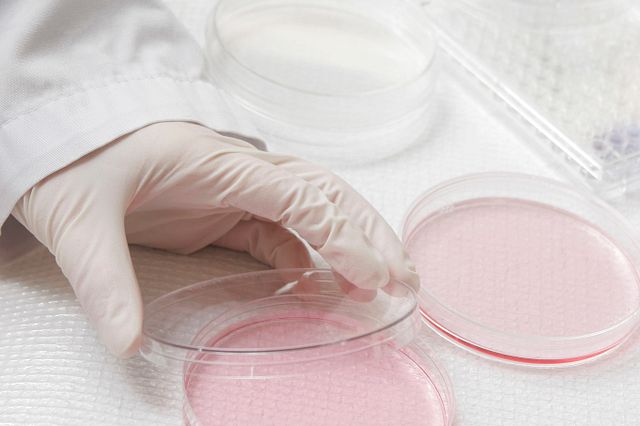ASTM F1980 Accelerated Aging for Sterile Medical AM Devices
The ASTM F1980 standard provides a method for accelerated aging of sterilized medical devices manufactured using additive manufacturing (AM) processes. This method is specifically tailored to ensure that these devices meet the stringent biocompatibility and performance requirements set forth by regulatory bodies such as the U.S. Food and Drug Administration (FDA).
Accelerated aging tests are essential for assessing the long-term stability of materials used in medical applications, particularly those exposed to sterilization processes like ethylene oxide (EO) or gamma irradiation. By using controlled environmental conditions that mimic real-world exposure over extended periods, the ASTM F1980 method allows manufacturers and quality assurance teams to identify potential degradation issues early in the product lifecycle.
The standard specifies a series of tests designed to evaluate the physical and chemical properties of AM devices after undergoing accelerated aging. These tests include measuring changes in mechanical strength, dimensional stability, and surface integrity. Additionally, biocompatibility assessments are performed post-aging to ensure that any potential degradation does not compromise the safety or efficacy of the device.
The process begins with selecting appropriate specimens made from the same raw materials as those intended for commercial use. The specimens undergo sterilization using methods consistent with those proposed for clinical use. After sterilization, they are subjected to accelerated aging conditions which can include temperature cycling, humidity exposure, and UV radiation. The duration of these exposures is carefully controlled according to the specific requirements outlined in ASTM F1980.
Once the specimens have completed their prescribed aging regimen, detailed characterization studies are conducted. Key parameters measured include tensile strength, modulus, impact resistance, water absorption, and surface roughness. For biocompatibility evaluation, tests such as cytotoxicity assays, hemolysis testing, and allergic contact dermatitis assessments may also be performed.
The data gathered from these tests is then analyzed to determine whether the aged specimens still meet all applicable standards including those defined by ASTM F1980 itself. Compliance with this standard ensures that manufacturers can confidently market their products as safe and effective for use in healthcare settings.
Implementing ASTM F1980 into your quality assurance protocol not only enhances product safety but also demonstrates commitment to regulatory compliance—a critical factor in maintaining trust among patients, healthcare providers, and regulatory agencies alike. By adhering strictly to the prescribed procedures outlined within this standard, you ensure that your additive manufactured medical devices remain reliable throughout their intended service life.
In summary, ASTM F1980 offers a robust framework for evaluating the long-term stability of sterilized AM medical devices. Its detailed protocols provide valuable insights into how these materials behave under various environmental stresses, ultimately helping to maintain high levels of product quality and patient safety.
Benefits
Implementing ASTM F1980 accelerated aging for sterile medical AM devices brings several key advantages:
- Enhanced Product Quality: The method provides a comprehensive assessment of the physical and chemical properties of your additive manufactured components, ensuring they remain robust and reliable over time.
- Better Predictability: By simulating real-world exposure conditions in controlled laboratory settings, you gain greater predictability regarding potential issues that may arise during prolonged use.
- Improved Compliance: Following ASTM F1980 helps ensure your products meet strict regulatory standards, thereby streamlining the approval process and minimizing compliance risks.
- Increased Confidence: Demonstrating adherence to recognized international standards builds trust with stakeholders including regulators, healthcare providers, and end users.
- Economic Efficiency: Early detection of any quality issues through accelerated aging saves time and resources by avoiding costly recalls or redesigns later in the development cycle.
- Sustainability: Ensuring product longevity reduces waste while promoting responsible resource management practices.
These benefits contribute to a more efficient, effective, and sustainable manufacturing process—one that ultimately delivers safer, higher-quality medical devices to patients worldwide.
Customer Impact and Satisfaction
The implementation of ASTM F1980 accelerated aging for sterile medical AM devices has significant positive impacts on customers:
- Increased Trust: By adhering to stringent testing protocols, you demonstrate a commitment to excellence, which fosters customer confidence in your products.
- Better Patient Outcomes: Ensuring that your additive manufactured medical devices are biocompatible and remain stable over their service life contributes directly to improved patient health outcomes.
- Enhanced Reputation: A reputation for producing high-quality, reliable medical devices enhances your brand image and market position.
- Improved Customer Satisfaction: Customers appreciate products that perform consistently well, leading to higher levels of satisfaction and loyalty.
- Stronger Relationships: When customers know their trust in you is warranted, they are more likely to form long-term relationships with your company.
All these factors contribute to greater customer impact and satisfaction, ultimately driving business success.
Environmental and Sustainability Contributions
The use of ASTM F1980 accelerated aging for sterile medical AM devices also has notable environmental and sustainability contributions:
- Reduced Waste: By identifying potential quality issues early in the development process, you avoid producing defective products that would otherwise end up as waste.
- Sustainable Materials: Ensuring that your materials maintain their integrity over time supports sustainable practices by promoting efficient use of resources.
- Energy Efficiency: The testing procedures help optimize energy consumption during manufacturing, contributing positively to overall environmental impact.
- Resource Conservation: By extending the lifespan of medical devices through robust testing, you contribute to conservation efforts aimed at reducing waste and conserving natural resources.
- Emission Reduction: The process helps minimize emissions associated with both production and disposal of defective products.
Incorporating these sustainable practices into your operations aligns with global sustainability goals and positions you as a leader in responsible manufacturing.





